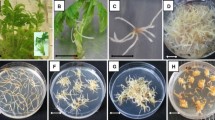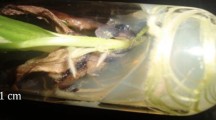Abstract
Hairy root cultures of Physalis minima L. were developed using Agrobacterium rhizogenes, strain ATCC 15834 mediated transformation and grown in half strength of Murashige and Skoog medium containing 8% (w/v) sucrose. Media supplementation with 1 mg naphthalenacetic acid l−1 and 1 mg benzyladenine increased solasodine glycoside up to 900 g dry wt, which was 20 times higher than that in the native root.
Similar content being viewed by others
References
Alvarez MA, Rodriguez TJ, Paniego NB, Giulietti AM (1994) Solasodine production in transformed organ cultures (roots and shoots) of Solamun eleagnifolium Cav. Biotechnol. Lett. 16: 393–396.
Argolo AC, Charlwood BV, Pletsch M (2000) The regulation of solasodine production by Agrobacterium rhizogenestransformed roots of Solanum aviculare. Planta Med. 66: 448–451.
Cham BE, Daunter B, Evans RA (1991) Topical treatment of malignant and premalignant skin lesions by very low concentration of a standard mixture (BEC) of solasodine glycosides. Cancer Lett. 59: 183–192.
Cham BE, Gilliver M, Wilson L (1987) Antitumor effects of glycoalkaloids isolated from Solanum sodomaeum. Planta Med. 53: 34–36.
Gottlieb HE, Cojocaru MSinha SC (1987) Withaminimin, a withanolide from Physalis minima. Phytochemistry 26: 1801–1804.
Ikeda T, Ando J, Miyazono A, Zhu XH, Tsumagari H, Nohara T, Yokomizo K, Uyeda M (2000) Anti-herpes virus activity of Solanum steroidal glycosides. Biol. Pharm. Bull. 23: 363–364.
Ishiyama M, Shoyama Y, Murakami H, Shinohara H (1996) Production of monoclonal antibodies development of an ELISA for solamargine. Cytotechnology 18: 153–158.
Jualang GA, Marziah M, Radzali M, Johari R (2002) Establishment of Physalis minima hairy roots culture for the production of physalins. Plant Cell Tiss. Org. Cult. 69: 271–278.
Kittipongpatana N, Hock RS, Parter JR (1998) Production of solasodine by hairy root, callus, and cell suspension cultures of Solanum aviculare Forst. Plant Cell Tiss. Org. Cult. 52: 133–143.
Mulchandami NB, Iyer SS, Badheka LP (1979) Physalin D, a new 13, 14-seco-16, 24-cyclo steroid from Physalis minima. Planta Med. 37: 268–273.
Murashige T, Skoog F (1962) A revised medium for rapid growth and bioassays with tabacco tissue cultures. Physiol. Plant. 15: 473–497.
Putalun W, Tanaka H, Yahara S, Lhieochaiphan S, Shoyama Y (2000) Survey of solasodine-type glycoalkaloids by Western blotting and ELISA using anti-solamargine monoclonal antibody. Biol. Pharm. Bull. 23: 72–75.
Author information
Authors and Affiliations
Rights and permissions
About this article
Cite this article
Putalun, W., Prasarnsiwamai, P., Tanaka, H. et al. Solasodine glycoside production by hairy root cultures of Physalis minima Linn.. Biotechnology Letters 26, 545–548 (2004). https://doi.org/10.1023/B:BILE.0000021953.50300.52
Issue Date:
DOI: https://doi.org/10.1023/B:BILE.0000021953.50300.52




